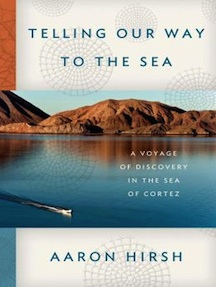By David L. Kirchman
Aaron Hirsh takes the reader along with a class of twelve students to a small, remote fishing village on the Sea of Cortez, that thin body of water separating Baja California from the rest of Mexico. There we learn of the sea’s natural history and ecology, theories of evolution, Darwinian and otherwise, with a good dose of German Idealism, Hernán Cortés and his conquest of Mexico, and Thomas Kuhn’s paradigms. Expositions in plant enzymology and isotope biogeochemistry are leavened by lyrical passages of onyx water and gibbous moons. The sea’s animals (and a couple plants and a dog) are the springboards for the book’s main themes. Their scientific names are the chapter titles, starting with Isoticopus fuscus, the brown sea cucumber. The subtitle to that first chapter, “Learning to see,” could have been the title to the book. Another indication of the book’s direction comes even earlier, in an epigraph from Claude Lévi-Strauss: some organisms are chosen because they are “good to think with.”
Along with the organisms, the students (and a hurricane) are the main characters in the book, and their interactions with Hirsh and Veronica, his wife and fellow instructor, give the book its narrative structure. There is Cameron, blind and missing a left leg, who maneuvers deftly on land and during the many scuba dives in the book. We follow the intellectual maturation of Rafe, an Australian with a gold earing and long blond ponytail. There is a hint of romance between Ace and Haley, a tall beauty who hears the town’s gossip while playing basketball with the local kids. (Everyone in the book seems fluent in Spanish.) Anoop was chosen for the course in spite of his answer to the question about his swimming abilities: “last time I checked, I was competent in breast stroke.” (He could barely keep afloat.) Another overachieving student, Becca, irritates all and never fits in. She and the hurricane provide a bit of dramatic tension.
The students and reader do learn about the ecology and evolution of several marine animals, including the whales that make the Sea of Cortez famous among nature enthusiasts. But there is also much about epistemology and our ways of perceiving nature and the world around us. Hirsh tells us of how Cortés and other early European explorers saw the New World through the past experiences of the old. Scientists have to work with blinders on, focusing on their “normal science” before a Kuhnian paradigm shift is possible. Although Cameron cannot see the whales he can hear them better than the other students. Rafe thinks that Japanese scientists placed cows (and not some other mammal) in a phylogenetic tree for whales because they unconscientiously consider them to be morally equivalent and equally fair game.
Hirsh also makes the students and reader realize that the Sea of Cortez is not as pristine or remote as appearances suggest. The students swam with a school of devil rays (Mobula lucasana, with the subheading “The End of Nature”), but only the oldest locals have seen the much larger version of manta rays, Manta birostris. Pearl oysters, large skipjack, and yellowfin tuna are all fished out; even the sea cucumber is threatened. Overfishing is the main culprit for the demise of Totoaba macdonaldi, but survival of this large anadromous fish wasn’t helped by the reduction of its nursery, the Colorado River, to a trickle by thirsty lawns and golf courses from Denver to San Diego.
Although there are other dark tales, this is a sunny book, often funny and sweet, always thoughtful and informative. We see through Hirsh that the Sea of Cortez is still a wondrous ecosystem, full of amazing life, in spite of its depreciations. We want to go there with Hirsh as our guide. He ends the book with musings about society’s capacity for dealing with environmental problems. He wonders if our “perception equipment” is adequate for understanding the scale at which we alter the world. Probably not, but Hirsh is optimistic. We can only hope he is right.
David L. Kirchman (ΦBK, Lawrence University, 1976) is the Maxwell P. and Mildred H. Harrington Professor Marine Biosciences at the University of Delaware and a resident member of the Alpha of Delaware chapter of Phi Beta Kappa.




